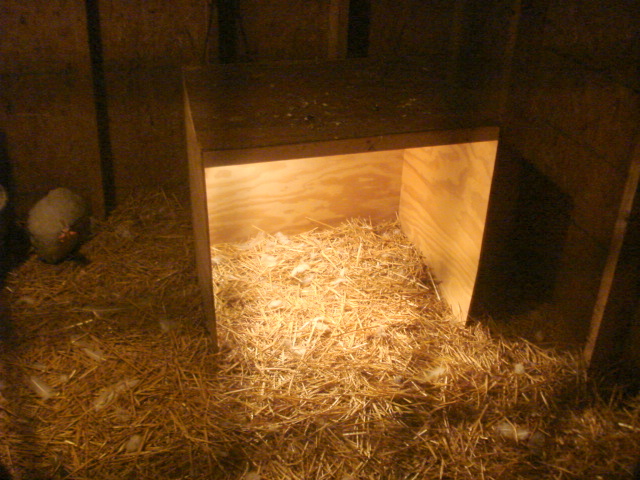 |
|
Poultry Hotbox  When I started keeping poultry 16 years ago, I, like so many others, accepted the advice that "you donít have to worry about birds during the winter" and "they will be just fine". A body covered with feathers seemed to be all the logic needed on that front. Having once owned a down filled winter coat, that made a lot of sense since I knew how toasty that coat was, and I really did not think through the mechanics of the two. At first, I didnít question it. Yet, the more I observed birds during the winter, the more I saw behaviors that showed me they were getting cold and what they did to help with that. What is important to understand is that birds use food, behaviors and the environment to manage their body temperatures. Birds in fact, possess a high degree of thermoregulation behaviors to help them keep cool and warm. To keep warm, they had behaviors like tucking their head under their wings (on the coldest nights) or standing on one foot to minimize heat loss through the skin. They fluff their feathers to trap air to warm and hold against their skin. I also observed they consumed much more food for energy to stay warm throughout the winter, which I think is something we all observe! My flock became very sedentary when temps really dropped to minimize their energy requirements, which were focused on keeping core temperatures where they needed to be. I began to develop protocols with herbal oils and suet to provide energy from the fat. Old timers recommended giving scratch with corn high in carbs, which by the way, is not as efficient as fats. Poultry gather and dispel body heat mostly through the skin. Birds can also lower their body temperature to use less energy due to inactivity or food being scarce. To help with this there is a critical exchange of energy via the way of foods to help balance the exchange. So, I had to acknowledge there were energy demands needed in exchange for keeping warm. Metabolic heat must be balanced by sufficient energy consumption from what is expended. Staying warm is not such an easy task by simply being covered by a bunch of feathers. I was then curious to find out if simply giving energy via the way of food, shelter and supplements was enough support to help keep my flock warm during the winter. Did they really not need supplemental heat beyond those things? Time to experiment! I wanted to see if they would choose, free choice, an external heat source even with all the other amenities I provided to help them. I knew people were putting heat lamps above the roosts in their coops, but that did not seem like a choice to me, since they normally roost as it is. So I constructed a 2x2x2 wood box with one side open with a lamp with a 100 watt bulb in one of the upper corners and I named it the "hotbox". I put the box on the floor in a low traffic area of the coop. A safety tip: I always "plug up" so if the lamp is dislodged, it will become unplugged. What I learned was very interesting.
1) Perhaps one of the most dramatic discoveries was that the birds used the heat to help themselves back to wellness. Birds who stayed under the lamp for 3 days or longer would eventually display symptoms related to illness, unless they were able to shake it off, via help from the heat of the lamp. One way was to use the external heat to say warm so they could redirect their energy to fight the "bug". I also think they used the heat to raise body temps to mimic a fever to also help fight the illness. Birds will turn their faces towards the sun to gain body heat and some of these birds would put their faces and heads inches away from the bulb. Sometimes they were too ill for this first line of defense and I had to bring them inside my house for further treatment. But it helped to alert me to an illness situation that I would not have detected otherwise. I had no idea they were dealing with something until they initially went into the hotbox. 2) I have a lot of birds 10+ years of age, and a couple of years ago had two, 15-16 years old. The last couple of years of their lives, they spent quite a bit of time under the lamps during winter. I suspect their circulation was not as good in old age as it is in a younger bird. They needed the warmth the lamp provided, because even herbs were not enough to support the circulation support and energy demands they needed. Additionally: 3) Sometimes even a healthy bird has an "off" day, or needs a warm boost for a half an hour. The warmth makes them feel good and perhaps relieves stress. Sometimes it is a gathering place for grooming and socializing. This is promoting healthy behavior for birds that are confined during winter and stress levels may increase because of that. 4) They also used the hotbox in non-cold weather to dry their feathers if they get caught in a rainstorm and get drenched. I do not have to bring them in to help them dry off. I look at the hotbox as a health aid, not as "heating the coop". My flockís behavior in the hotbox has shown me how they utilize it to great effect. And the bonus is it can also be used as a brooder as well during breeding season! Source: |